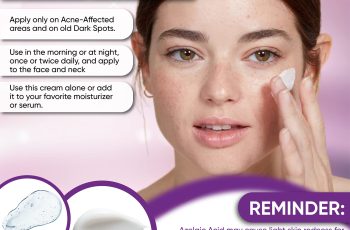
Can Salicylic Acid, Niacinamide, and Hyaluronic Acid be Mixed?
If you’re feeling overwhelmed with skincare, stop by because I’m here today to make sure everything makes a little more sense. I don’t blame you for finding it all so confusing.
It seems like every week there’s a new ingredient that pops up that you absolutely need to incorporate into your daily routine. So when everything piles up, it can be a little overwhelming to figure out in what order to apply the ingredients!
Hopefully by the end of today’s blog post, you’ll find mixing salicylic acid, niacinamide, and hyaluronic acid is as easy as turning on a kettle. So stay tuned and learn more.
Can I use salicylic acid with hyaluronic acid and niacinamide?
Yes, you can, believe it or not! Since salicylic acid is a strong antibacterial and anti-acne agent, severe skin dryness and irritation are common side effects. That’s where the skin-moisturizing combination of hyaluronic acid and niacinamide comes into play. Each of these humectants works by binding moisture to the skin’s surface to combat skin dryness. They also target damage caused by free radicals like pollution, UV rays, and other environmental aggressors. When it comes to the best order to use these ingredients, I recommend the following for the best skin results with few side effects: Cleanser. Exfoliating toner enriched with salicylic acid. Hyaluronic acid serum. Niacinamide serum moisturizer (ideal) SPF (daytime only). The reason I recommend using hyaluronic acid before niacinamide is because hyaluronic acid can provide your skin with impressive hydration benefits. This allows niacinamide to work its unique benefits and regulate sebum production (natural oils in your skin) at the surface of the skin. Can salicylic acid and hyaluronic acid be mixed?
You can use both acids at the same time. In fact, many skin care experts recommend using both products together in your skin care routine. By incorporating hyaluronic acid into your daily routine, you can deeply hydrate and moisturize your skin to restore balance.
The advantage of combining hyaluronic acid and salicylic acid is that they do not interfere with each other. Salicylic acid is the most commonly used salicylic acid in skin care formulas because of its impressive properties in fighting bacteria that often cause acne.
It unclogs pores filled with bacteria, impurities, and excess oil by penetrating deeper into the skin layers. Salicylic acid works to open up the pores, while hyaluronic acid works on the outer surface of the skin and keeps the pores open
keeping the barrier hydrated and at its healthiest.
If you want to learn more about how to layer hyaluronic acid with salicylic acid, check out our blog post. Can Salicylic Acid and Niacinamide be mixed? Mixing these powerful ingredients is okay, but it should be done with caution. While both products are welcome additions to the skin, combined they make for a powerful combination.
As I mentioned before, the popular BHA penetrates deep into the pores to clear out all sorts of excess oil, bacteria, and debris. Niacinamide complements this by repairing and stimulating the growth of skin cells, while also drawing moisture throughout the face and locking it in place, keeping the barrier fully hydrated and functioning properly.
We have a very special blog post on how to use serums salicylic acid and niacinamide together. How do hyaluronic acid and salicylic acid apply? That depends on the makeup of these ingredients. You may have never thought about the order in which you apply your skincare products.
However, it is an important part of making sure you reap the benefits in your daily routine. If you’ve read any of our previous blog posts, you know that skincare products should be applied in order from thinnest to thickest. This way, you can ensure that each product formula is absorbed into the skin without conflicting with the barrier created by thicker formulas on your face.
Hyaluronic acid is primarily found in gel-like serums that can be applied to the skin after using a salicylic acid-rich cleanser. This not only soothes the skin, but also increases the skin’s moisture level so that it can better absorb the other products you apply afterwards.
Can AHA BHAs be used with hyaluronic acid?
Yes, of course. The beauty of hyaluronic acid is that it can be used on all skin types and with all ingredients. It works well as a team and can be very effective in neutralizing skin irritation caused by strong BHAs (like salicylic acid) and AHAs (like glycolic acid). Since AHAs and BHAs are often found in exfoliating toners or lightweight serums, use a chemical exfoliant before removing any residue. Dead skin cells, dirt, debris, and impurities are removed before the skin can be rejuvenated and balanced with hyaluronic acid. Can I use two salicylic acid products at the same time? It is possible, but make sure you use the best possible products to reap the benefits and avoid side effects. Salicylic acid is very effective and can also be great for fighting blemishes, pimples, and acne-causing bacteria.
You will often find different percentages in different formulas, from cleansers and serums to masks and topical anti-acne treatments.
This is something you must take into account when using skincare products. If you limit your daily use of salicylic acid to once a day, you will definitely see results without any side effects. If you already have multiple
If you have a product containing BHA, you can alternate the days or times you apply it to your face.
Does a moisturizer contain salicylic acid?
Moisturizer should be one of the last steps in your skincare routine. This is because it tends to be the thickest and can prevent other products from penetrating the skin if applied too early. Although serums are often considered
Although products are considered to deliver more active ingredients to the skin than moisturizers, moisturizers can still provide protection for the face.


